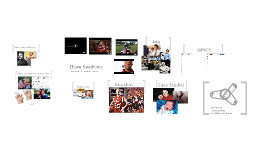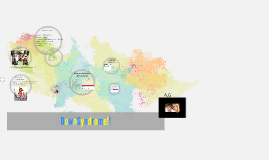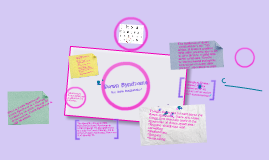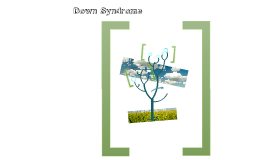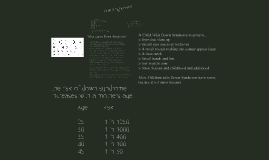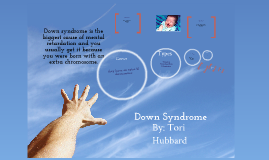Down Syndrome
Transcript: Down Syndrome Almost half of babies with Down syndrome have heart defects (3). Some defects are minor and may be treated with medications, while others require surgery. Vision problems: More than 60 percent of children with Down syndrome have vision problems, including crossed eyes (esotropia), near- or far-sightedness and cataracts Down syndrome is one of the most common genetic birth defects. It affects about 1 in 800 (about 3,400) babies a year in the United States Down syndrome is a disorder that includes a combination of birth defects individuals affected have some degree of l disability, characteristic facial features and, often, heart defects and other health problems. Down syndrome is caused by extra genetic material from chromosome 21. Memory loss: Individuals with Down syndrome are more likely than unaffected individuals to develop Alzheimer’s disease, which is characterized by progressive memory loss, personality changes and other problems. Leukemia: Fewer than 1 in 100 children with Down syndrome develop leukemia Can Down syndrome be cured? There is no cure for Down syndrome. However, some studies suggest that women who have certain versions of some genes that affect how their bodies metabolize (process) the B vitamin folic acid may be at increased risk for having a baby with Down syndrome What does a child with Down syndrome look like? A child with Down syndrome may have: •Eyes that slant upward •Small ears that may fold over a little at the top •A small mouth, making the tongue appear large •A small nose with a flattened nasal bridge •A short neck •Small hands and feet •Low muscle tone •Short stature in childhood and adulthood Most children with Down syndrome have some, but not all, of these features. How do children with Down syndrome develop? Children with Down syndrome are usually smaller, and their physical and mental developments are slower, than youngsters who do not have Down syndrome. What is the cause of Down syndrome? Although many theories have been developed, it is not known what actually causes Down syndrome. Some professionals believe that hormonal abnormalities, X-rays, viral infections, immunologic problems, or genetic predisposition may be the cause of the improper cell division resulting in Down syndrome. What can a child with Down syndrome do? Children with Down syndrome usually can do most things that any young child can do, such as walking, talking, dressing and being toilet-trained. However, they generally start learning these things later than unaffected children. As teenagers, children with Down syndrome reach puberty at the same age as other children. As teenagers they develop typical leisure interests and awareness of sexuality.[4] The point being stressed is that we believe that it is important to recognise that the social and emotional needs of children, teenagers and adults are age-appropriate. Down syndrome is usually identified at birth or shortly thereafter. Initially the diagnosis is based on physical characteristics that are commonly seen in babies with Down syndrome. These include low muscle tone, a single crease across the palm of the hand, a slightly flattened facial profile and an upward slant to the eyes. There are two kinds of testing that can be done during a pregnancy - diagnostic testing such as amniocentesis and chorionic villi sampling (CVS), and screening testing such as ultrasound (sonogram) and maternal serum screening tests. Does the risk of Down syndrome increase with the mother’s age? Yes. The risk of Down syndrome increases with the mother’s age (7): •At age 25, the risk of having a baby with Down syndrome is 1 in 1,250. •At age 30, the risk is 1 in 1,000. •At age 35, the risk is 1 in 400. •At age 40, the risk is 1 in 100. •At age 45, the risk is 1 in 30. Can people with Down syndrome have children? With rare exceptions, men with Down syndrome cannot father a child (3). A woman with Down syndrome has a 50-50 chance of conceiving a child with Down syndrome, but many affected fetuses are miscarried.






